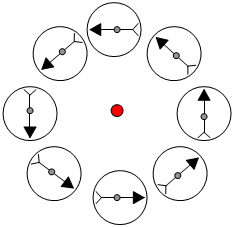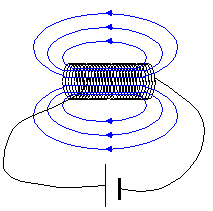GCSE Science/Magnetic effects of a current
< GCSE Science  |
When a current flows down a wire it creates a magnetic field. To see this, place a small plotting compass near the wire and turn the current on. The compass needle will deflect. The shape of the magnetic field around a wire is circular. Look at the diagram on the right. The wire is coming straight out of the screen so you only see it's cross section (the red circle) The plotting compasses show how the field wraps around the wire.
Creating an electromagnet
Solenoids are made by coiling wire. The magnetic field of a solenoid looks like the field of an ordinary bar magnet.

A solenoid makes a pretty weak bar magnet on its own, but if a piece of iron is put inside the solenoid, the field becomes much much stronger.
Try the following experiment:
- Wrap a piece of plastic coated wire around a pencil.Remove the pencil then connect to a power supply set at 1V DC current. Sprinkle iron filings around the coil of wire. Put a plotting compass near the wire. Try to pick up a paper clip.
- Wrap a piece of plastic coated wire around a large nail. Repeat all of the above experiments
You will find that the solenoid with the iron core is much much stronger than the one with the air core.
Q1) Why is it important to use plastic-coated wire?
Making the field stronger
To make the field stronger we can:
- Use a soft iron core
- Increase the amount of current flowing in the wire
- Increase the number of turns on the solenoid.
Reversing the field
To make the north pole and south pole swap positions we can:
- Reverse the direction of the current by swapping the positive and negative leads on the power pack.
- Wind the wire the other way round. {So if you wound it clockwise, take it off and wind it counterclockwise.
Speaking of north and south poles, there is a little trick to help find out which end is the north pole and which is the south.
Look down the solenoid and work out which way the current is flowing. Remember, current flows from the positive to the negative terminal on the power pack. If the current is flowing clockwise, the end will be a south pole. If it is going counterclockwise, the end will be a north pole. The easy way to remember this is to put arrows on the end of a capital N and S like this:

If you do not understand how to determine the pole using the clockwise and anti-clockwise way you can use the right hand grip rule